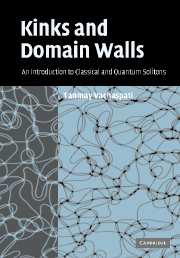Book contents
- Frontmatter
- Contents
- Preface
- 1 Classical kinks
- 2 Kinks in more complicated models
- 3 Interactions
- 4 Kinks in quantum field theory
- 5 Condensates and zero modes on kinks
- 6 Formation of kinks
- 7 Dynamics of domain walls
- 8 Gravity and cosmology of domain walls
- 9 Kinks in the laboratory
- Appendix A Units, numbers and conventions
- Appendix B SU(N) generators
- Appendix C Solution to a common differential equation
- Appendix D Useful operator identities
- Appendix E Variation of the determinant
- Appendix F Summary of cosmological equations
- References
- Index
2 - Kinks in more complicated models
- Frontmatter
- Contents
- Preface
- 1 Classical kinks
- 2 Kinks in more complicated models
- 3 Interactions
- 4 Kinks in quantum field theory
- 5 Condensates and zero modes on kinks
- 6 Formation of kinks
- 7 Dynamics of domain walls
- 8 Gravity and cosmology of domain walls
- 9 Kinks in the laboratory
- Appendix A Units, numbers and conventions
- Appendix B SU(N) generators
- Appendix C Solution to a common differential equation
- Appendix D Useful operator identities
- Appendix E Variation of the determinant
- Appendix F Summary of cosmological equations
- References
- Index
Summary
The Z2 and sine-Gordon kinks discussed in the last chapter are not representative of kinks in models where non-Abelian symmetries are present. Kinks in such models have more degrees of freedom and this introduces degeneracies when imposing boundary conditions, leading to many kink solutions with different internal structures (but the same topology). Indeed, kink-like solutions may exist even when the topological charge is zero. The interactions of kinks in these more complicated models, their formation and evolution, plus their interactions with other particles are very distinct from the kinks of the last chapter.
We choose to focus on kinks in a model that is an example relevant to particle physics and cosmology. The model is the first of many Grand Unified Theories of particle physics that have been proposed [63]. The idea behind grand unification is that Nature really has only one gauge-coupling constant at high energies, and that the disparate values of the strong, weak, and electromagnetic coupling constants observed today are due to symmetry breaking and the renormalization-group running of coupling constants down to low energies. Since there is only one gauge-coupling constant in these models, there is a simple grand unified symmetry group G that is valid at high energies, for example, at the high temperatures present in the very early universe. At lower energies, G is spontaneously broken in stages, eventually leaving only the presently known quantum chromo dynamics (QCD) and electromagnetic symmetries SU(3)c × U(1)em of particle physics, with its two different coupling constants. It can be shown [63] that the minimal possibility for G is SU(5).
- Type
- Chapter
- Information
- Kinks and Domain WallsAn Introduction to Classical and Quantum Solitons, pp. 20 - 34Publisher: Cambridge University PressPrint publication year: 2006



